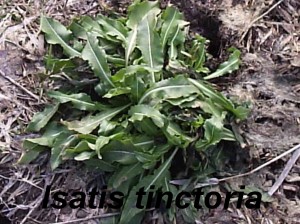When growing natural dye plants the hardest part is remembering when to harvest. Some plants reach a peak in colour and then degrade. Other plants stop growing, and need to be harvested to continue growing and producing dye. Some plants are harvested only in the fall, others once during the growing season, and some multiple times through out the season. For example madder and wild madders are harvested in fall. Goldenrod’s flowers make it a single harvest, late summer, plant. Harvest woad multiple times during the growing season. Woad likes being harvested two or three times during the growing season, more frequently in warmer climates. It will often grow with more vigor after a “haircut.” After each harvest the leaves will regrow, until a hard frost. Woad can be harvested after mild frost, but once the year’s killing frost comes it’s growth will cease.
When to harvest woad:
Harvest woad, for the first time, after the leaves reach about six inches in length, or the rosette is over eight inches in diameter. The first harvest frequently contains the highest concentration of possible indigo. In my location, the first woad harvest is possible by mid July. In warmer areas, the first harvest can happen in May or June. A second, third, or even fourth harvest are also possible, depending on climate. In my zone three area, three harvests of first year woad leaves is standard. In France, for instance, four or five first year harvests can be achieved. Standard timing for second harvest is between three to four weeks after the first, depending on plant regrowth.
Second year plants can also be harvested for dye. These plants should be harvested after two weeks of warm, sunny weather. But the harvest should be done before the flower-stalk emerge, as the flowers mush in the extraction vat. After the flower starts blooming, the woad flowers can be used for direct contact dyeing, along with any seeds that form.
How to harvest woad: first year plants
There are two methods to harvesting first year woad plants. In method one, you cut all the plant’s leaves off at the ground. Leaving the root intact to grow more leaves. In the second method, you carefully remove all the leaves over four inches in length. Leaving the smaller, centre leaves to nourish the plant and help it regrow.
I have used both the first and second methods, and the plants recover equally well from both. The first method gives you a higher volume for your first harvest. Higher volume means richer colors if you dye directly from the extraction vat, or more dye pigment to save.
The second method gives quicker recovery, and a slightly improved second harvest due to the higher volume of leaves available. It can also give a slight improvement in color depth for the second harvest, again only if you are dying from the extraction vat.
How to harvest woad second year plants:
Harvest woad’s second year plants, to prevent self-seeding, by eradicating them. When you don’t want them to self-seed, the best method is to use a wheelbarrow and garden fork. You use the garden fork to loosen the roots and pull up the plants. The wheelbarrow contains the plants, and you can remove the leaves for your extraction vat with ease.
This also negates some of the need for speed with your indigo extraction vat. Since the roots are still connected, the leaves do not wilt and will lose the indigo precursors slower than if they were cut from the roots immediately.
After removing the leaves from second year plants, you want the plants to dry out. If you throw the newly uprooted plants into the compost pile they can re-root and cause self-seeding problems later. This is a good technique to use if you live in an area with invasive Isatis tinctoria landraces, as you can remove them and still get the dye.
Remember, don’t forget to record your harvest time and technique so that you can get similar results next time. This is important more in regards to general weather, and conditions, rather than exact dates.
Back to you:
What experiences have you had growing woad? When do you harvest, and what harvest methods work for you?

[…] This Information To Get You Garden GrowingComposting at homeGrowing Cauliflower In Your GardenWoad Part 1: When to HarvestWeekly Weeder #27 – Birdsfoot Trefoil + Wildcrafting WednesdayWoad Part 1: When to […]